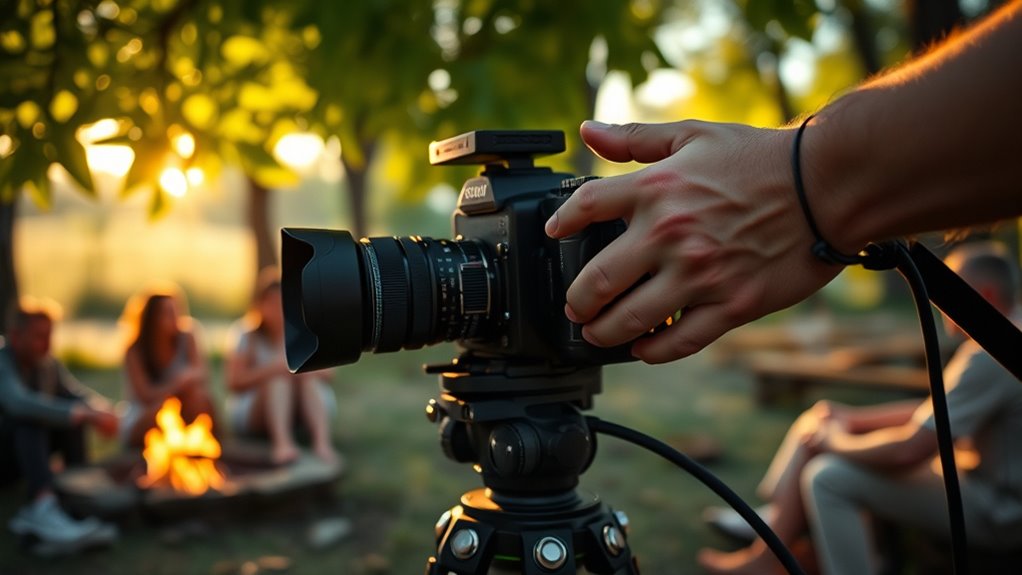To craft resonant narratives in videography, focus on visual storytelling that creates emotional engagement and supports your message. Use camera angles, lighting, and composition to evoke feelings and deepen viewer connections. Structure your story with a clear arc—beginning, middle, and end—while pacing it thoughtfully with music and silence. Authentic visuals and thoughtful editing help build a genuine emotional journey. Keep exploring these techniques to master the art of compelling storytelling that truly resonates.
Key Takeaways
- Utilize visual cues like lighting, composition, and camera angles to reinforce the story’s emotional message.
- Structure your video with a clear beginning, middle, and end to create a compelling narrative arc.
- Incorporate pacing, music, and silence to guide emotional flow and maintain viewer engagement.
- Use authentic visuals and close-up shots to evoke genuine feelings and foster personal connection.
- Apply interior design principles such as mood setting and thoughtful composition to enhance storytelling impact.

Have you ever watched a video that made you feel like you were right there in the story? That’s the power of effective storytelling in videography. It’s not just about capturing beautiful shots or technical skills; it’s about creating a narrative that resonates deeply with your audience. Visual storytelling is the backbone of this process. Every frame, color palette, and camera angle should work together to convey emotions and advance the story. When done well, viewers don’t just see the scene—they feel it. That emotional engagement is what transforms a simple video into a memorable experience. You want your audience to connect with your story on a personal level, and that begins with understanding how visuals can evoke feelings.
Great storytelling in videography makes viewers feel as if they are part of the story through powerful visuals.
To craft compelling narratives, you need to think beyond just what’s happening on screen. Consider the story you want to tell and how each shot can support that message. Use visual cues—such as lighting, composition, and movement—to guide viewers’ emotions. A close-up shot of a person’s face, for example, can reveal raw emotion, drawing viewers into their experience. Wide shots can establish context or isolate a character, heightening emotional impact. As you piece together these elements, remember that emotional engagement thrives on authenticity. Your visuals should reflect genuine feelings and situations, making it easier for viewers to relate and empathize.
Storytelling in videography isn’t just about what you show, but also about how you show it. The pacing of your edits, the choice of music, and even the silence between scenes contribute to the emotional flow. When you skillfully combine these elements, you create a narrative that holds viewers’ attention and sparks an emotional response. Don’t forget the importance of a clear story arc. Whether it’s a journey of hope, struggle, or triumph, structuring your footage around a beginning, middle, and end helps maintain coherence and emotional momentum. This structure creates a sense of satisfaction and resonance, making your story stick with viewers long after it ends.
Ultimately, your goal is to craft a story that feels real and compelling. Use visual storytelling techniques to evoke emotions, connecting your audience to your narrative on a deeper level. When viewers are emotionally engaged, your message becomes powerful and memorable. Incorporating visual storytelling techniques derived from interior design principles, such as thoughtful composition and mood setting, can enhance the emotional impact of your videos. Through intentional visuals, thoughtful pacing, and authentic storytelling, you can create videos that don’t just entertain but also inspire, provoke thought, or spark change. That’s the true essence of storytelling in videography—creating a connection that lasts.
Frequently Asked Questions
How Can I Incorporate Emotional Elements Into My Videography Storytelling?
To incorporate emotional elements into your videography storytelling, focus on visual symbolism that conveys feelings without words. Use shots, colors, and lighting to evoke specific emotions. Maintain emotional pacing by adjusting shot length and music to build or release tension. Engage your audience by highlighting genuine moments and expressions, making your visuals resonate deeply. This combination of visual symbolism and emotional pacing creates a compelling narrative that connects on a personal level.
What Are Common Mistakes to Avoid When Crafting a Narrative?
Avoid common mistakes like creating plot holes that confuse your audience, and overusing tropes that make your story predictable. You should guarantee your narrative flows logically, with clear cause-and-effect, and craft original ideas to keep viewers engaged. Don’t rely on clichés; instead, develop authentic characters and fresh perspectives. Focus on consistency and originality to make your story resonate emotionally and leave a lasting impression.
How Do I Tailor Stories for Different Target Audiences?
Imagine you’re a time traveler, adjusting your story like a chameleon to fit each era. You tailor stories for different target audiences by practicing audience segmentation, understanding their preferences, and values. Use cultural sensitivity to respect diverse backgrounds, ensuring your narrative resonates. Speak their language, address their needs, and avoid stereotypes. This way, your message hits home, creating a genuine connection that keeps viewers engaged and enthusiastic for more.
What Equipment Best Supports Storytelling in Low-Light Conditions?
You should invest in a camera with good low-light capabilities, like a mirrorless or DSLR with a fast lens. Use camera accessories such as external microphones and stabilizers to improve footage quality. Incorporate lighting techniques like using LED panels or reflectors to brighten scenes without harsh shadows. These tools and methods help you capture clear, engaging visuals that enhance your storytelling in challenging low-light conditions.
How Can I Measure the Effectiveness of My Storytelling?
Think of your story as a garden—you need to see how it grows. To measure its effectiveness, track audience engagement and storytelling metrics like view duration, shares, and comments. These indicators reveal if your narrative resonates or needs tweaking. You can also gather direct feedback through surveys or focus groups. By regularly analyzing this data, you guarantee your storytelling continues to flourish and connect deeply with your viewers.
Conclusion
So, now you’re a storytelling master—ready to make viewers cry, laugh, or question everything with your next video. Just remember, if your narrative doesn’t resonate, maybe it’s time to blame your camera, your editing skills, or that mysterious muse who’s clearly lost her way. Because at the end of the day, if your story doesn’t connect, it’s not your fault—it’s just your audience’s tragic inability to appreciate your genius. Happy filming!









